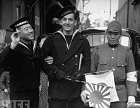James Fennell
Posts: 135
Joined: 12/25/2010
From: Gloucestershire
Status: offline

|
ISTAR: A quick note on recce, FAC and OP units.
The recon reveal feature opens up a lot of potential for new units, and the possiblity for tactics which enable small units to coordinate more precise air and artillery support to overmarch larger units. Most countries radically improved ISTAR over the 1948-85 period, inlcuding better trained infiltration and special forces, more observation aircraft and helicopters, improved SIGINT, battlefield ground and air search and tracking radars, IR lights and image intensifiers and laser target designators as well as improved long range yet lightweight communications systems.
From the British perspective this included:
- specialised Universal Carrier, Cromwell, Centurion, FV432 and Warrior OP vehicles (FV432s and Warriors with demountable radar systems)
- Daimler, Dingo, AEC, Ferret, Saladin, Fox, Scorpion, Scimitar and Sabre recon vehicles, as well as recce jeeps and landrovers
- close recce platoons in infantry battalions, parachute pathfinder platoons and marine commando recce platoons
- the Royal Marines arctic warfare cadre and highly trained SAS and SBS covert 'OP' teams to work behind the lines with target designators and image intensifiers
- Green Archer and Cymbeline mortar locating radars, either towed systems or those mounted on FV430 APCs
- ground surveillance radars either man portable or mounted on Ferret 2, FV432 and Warrior OP vehicles
- battlefield air search and tracking radars for the L70 bofors and Rapier SAM (Blindfire)
- Royal Artillery and Royal Air Force specialised laser target designation teams to work with front line troops
- Auster AOP 9, Skeeter, Sioux and Gazelle OP aircraft and helicopters attached to armoured and artillery units
- Harrier GR3, Jaguar GR1 and Tornado GR1 aircraft all had laser rangefinders and marked target spotters. This enabled greater precision using either iron bombs/rockets, CBUs or PGMs when targets were 'painted' by recce units with target designators or by Pave Spike equipped Buccaneers.
- the Pave Spike laser target designator pod was provided to Buccaneer squadrons in 1979, along with Paveway 1 PGMs
- Paveways were first used by Harrier GR3s in the Falklands, although designation was by ground based by SAS teams.
The picture shows a FV436 Cymbeline mortar locating radar system avaialable from 1975-85. Cymbeline replaced the Green Archer system which was towed by a Humber Pig and was in service from 1962-79.

 Attachment (1) Attachment (1)
< Message edited by James Fennell -- 8/14/2020 4:47:21 PM >
_____________________________
....gone to the dark side
|
 Printable Version
Printable Version





































 New Messages
New Messages No New Messages
No New Messages Hot Topic w/ New Messages
Hot Topic w/ New Messages Hot Topic w/o New Messages
Hot Topic w/o New Messages Locked w/ New Messages
Locked w/ New Messages Locked w/o New Messages
Locked w/o New Messages Post New Thread
Post New Thread